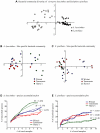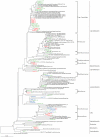Bacterial communities of two ubiquitous Great Barrier Reef corals reveals both site- and species-specificity of common bacterial associates
- PMID: 20454460
- PMCID: PMC2861602
- DOI: 10.1371/journal.pone.0010401
Bacterial communities of two ubiquitous Great Barrier Reef corals reveals both site- and species-specificity of common bacterial associates
Abstract
Background: Coral-associated bacteria are increasingly considered to be important in coral health, and altered bacterial community structures have been linked to both coral disease and bleaching. Despite this, assessments of bacterial communities on corals rarely apply sufficient replication to adequately describe the natural variability. Replicated data such as these are crucial in determining potential roles of bacteria on coral.
Methodology/principal findings: Denaturing Gradient Gel Electrophoresis (DGGE) of the V3 region of the 16S ribosomal DNA was used in a highly replicated approach to analyse bacterial communities on both healthy and diseased corals. Although site-specific variations in the bacterial communities of healthy corals were present, host species-specific bacterial associates within a distinct cluster of gamma-proteobacteria could be identified, which are potentially linked to coral health. Corals affected by "White Syndrome" (WS) underwent pronounced changes in their bacterial communities in comparison to healthy colonies. However, the community structure and bacterial ribotypes identified in diseased corals did not support the previously suggested theory of a bacterial pathogen as the causative agent of the syndrome.
Conclusions/significance: This is the first study to employ large numbers of replicated samples to assess the bacterial communities of healthy and diseased corals, and the first culture-independent assessment of bacterial communities on WS affected Acroporid corals on the GBR. Results indicate that a minimum of 6 replicate samples are required in order to draw inferences on species, spatial or health-related changes in community composition, as a set of clearly distinct bacterial community profiles exist in healthy corals. Coral bacterial communities may be both site and species specific. Furthermore, a cluster of gamma-proteobacterial ribotypes may represent a group of specific common coral and marine invertebrate associates. Finally, the results did not support the contention that a single bacterial pathogen may be the causative agent of WS Acroporids on the GBR.
Conflict of interest statement
Figures






Similar articles
-
Analysis of the coral associated bacterial community structures in healthy and diseased corals from off-shore of southern Taiwan.J Environ Sci Health B. 2010 Jul;45(5):408-15. doi: 10.1080/03601231003800032. J Environ Sci Health B. 2010. PMID: 20512731
-
Bacterial associates of two Caribbean coral species reveal species-specific distribution and geographic variability.Appl Environ Microbiol. 2012 Sep;78(18):6438-49. doi: 10.1128/AEM.01162-12. Epub 2012 Jul 6. Appl Environ Microbiol. 2012. PMID: 22773636 Free PMC article.
-
Diversities of coral-associated bacteria differ with location, but not species, for three acroporid corals on the Great Barrier Reef.FEMS Microbiol Ecol. 2009 May;68(2):152-63. doi: 10.1111/j.1574-6941.2009.00666.x. Epub 2009 Mar 19. FEMS Microbiol Ecol. 2009. PMID: 19302548
-
Defining the Core Microbiome in Corals' Microbial Soup.Trends Microbiol. 2017 Feb;25(2):125-140. doi: 10.1016/j.tim.2016.11.003. Epub 2016 Dec 3. Trends Microbiol. 2017. PMID: 27919551 Review.
-
Coral-associated bacterial assemblages: current knowledge and the potential for climate-driven impacts.Integr Comp Biol. 2010 Oct;50(4):662-74. doi: 10.1093/icb/icq061. Epub 2010 Jun 3. Integr Comp Biol. 2010. PMID: 21558231 Review.
Cited by
-
Species Specificity of Bacteria Associated to the Brown Seaweeds Lobophora (Dictyotales, Phaeophyceae) and Their Potential for Induction of Rapid Coral Bleaching in Acropora muricata.Front Microbiol. 2016 Mar 21;7:316. doi: 10.3389/fmicb.2016.00316. eCollection 2016. Front Microbiol. 2016. PMID: 27047453 Free PMC article.
-
Is promiscuity associated with enhanced selection on MHC-DQα in mice (genus Peromyscus)?PLoS One. 2012;7(5):e37562. doi: 10.1371/journal.pone.0037562. Epub 2012 May 23. PLoS One. 2012. PMID: 22649541 Free PMC article.
-
Bacterial communities of the gorgonian octocoral Pseudopterogorgia elisabethae.Microb Ecol. 2013 Nov;66(4):972-85. doi: 10.1007/s00248-013-0267-3. Epub 2013 Aug 4. Microb Ecol. 2013. PMID: 23913197
-
Highly heterogeneous bacterial communities associated with the South China Sea reef corals Porites lutea, Galaxea fascicularis and Acropora millepora.PLoS One. 2013 Aug 7;8(8):e71301. doi: 10.1371/journal.pone.0071301. Print 2013. PLoS One. 2013. PMID: 23940737 Free PMC article.
-
Comparing bacterial community composition between healthy and white plague-like disease states in Orbicella annularis using PhyloChip™ G3 microarrays.PLoS One. 2013 Nov 20;8(11):e79801. doi: 10.1371/journal.pone.0079801. eCollection 2013. PLoS One. 2013. PMID: 24278181 Free PMC article.
References
-
- LaJeunesse TC. “Species” radiations of symbiotic dinoflagellates in the Atlantic and Indo-Pacific since the miocene-pliocene transition. Mol Biol Evol. 2005;22:570–581. - PubMed
-
- Rohwer F, Seguritan V, Azam F, Knowlton N. Diversity and distribution of coral-associated bacteria. Marine Ecology-Progress Series. 2002;243:1–10.
-
- Bourne DG, Munn CB. Diversity of bacteria associated with the coral Pocillopora damicornis from the Great Barrier Reef. Environ Microbiol. 2005;7:1162–1174. - PubMed
-
- Rappe MS, Giovannoni SJ. The uncultured microbial majority. Annu Rev Microbiol. 2003;57:369–394. - PubMed
-
- Kellogg CA. Tropical Archaea: diversity associated with the surface microlayer of corals. Marine Ecology-Progress Series. 2004;273:81–88.
Publication types
MeSH terms
Substances
LinkOut - more resources
Full Text Sources

